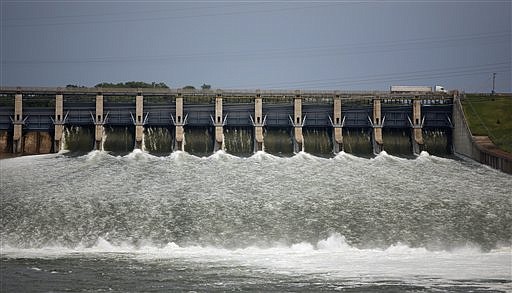OMAHA, Neb. (AP) - The Army Corps of Engineers says it is trying to improve the way it manages the Missouri River's reservoirs after last year's historic flooding, but the 2012 plan released Friday doesn't include much additional flood-storage space.
The corps has been criticized by people living all along the river because of the way it managed last year's flood that caused $630 million damage to flood-control structures and covered hundreds of thousands of acres of farmland along the 2,341-mile-long river for months.
The corps said it tried to address some concerns by promising to improve communication and react swiftly to signs of high runoff, but officials say there wasn't time to clear much more space than normal in the reservoirs.
"The selected drawdown strategy was designed to evacuate stored flood water as quickly as possible to allow people to get back into their homes, farms and businesses to begin the process of recovery, and to allow inspection and repair of infrastructure including the dams and levees to ensure they are ready for the 2012 season," the corps said in the plan.
Officials are studying whether the corps needs to increase the 16.3 million acre-feet of space that's normally cleared out each spring for flood control purposes. That study won't be completed until March, so it won't affect this year's plan, and even if the corps decides that more flood control space is needed, officials will have to examine how that would affect all the other purposes of the river that require more water: irrigation, navigation, hydroelectric power generation, water supply, water quality, recreation, and fish and wildlife enhancement.
Officials say the levees, dams and channels along the river remain vulnerable going into 2012 because many more repairs are needed, but they are working to complete critical repairs before spring.
In northwest Missouri where some of the worst flooding was last year, Holt County clerk Kathy Kunkel said she's disappointed the corps won't clear out more space in the reservoirs. Kunkel said she doesn't expect all the 32 levee breaches in her county to be repaired before spring, so the area may flood after any significant rain.
"We've got to go back to what this system was designed for, and that's flood control," Kunkel said.
The corps said there is only a 10 percent chance that the amount of water flowing into the Missouri River from melting snow and rainfall this year will exceed the amount the plan can handle.
If this winter's relatively mild weather continues, that would reduce flood concerns along the Missouri River but wouldn't necessarily prompt changes in the corps' management plan.
South Dakota state climatologist Dennis Todey said conditions throughout the Missouri River basin appear much drier this year than at the same time last year, but that the peak snow season remains ahead.
The Corps' Jody Farhat, who oversees the six dams along the river, said under the current forecast, she expects the reservoirs will have slightly more space than normal available at the start of March.
"We feel like the path that we're on is good for the conditions we're seeing," Farhat said.
Last year, the corps had to release massive amounts of water from the six dams along the river all summer to deal with unexpectedly heavy rain in May and above-average mountain snowpack. That caused flooding that began in June and continued well into the fall in some places.
Cliff Morrow, who farms near Tekamah, Neb., not far from the river said he can't believe the corps isn't clearing out more space in the reservoirs for flood control. About half of his family's 1,000 acres were under water all last summer, and he worries about another flood if this spring's rain and snow is unusually heavy again.
"It's too bad when we have to rely on luck to stay away from a flood when good management would have done the same thing," Morrow said. "They could be draining water right now, but they choose not to."
A report from outside experts released last month said the corps did the best it could to deal with last year's record flooding, but the panel recommended several changes that could prevent a disastrous repeat.
The corps said it has already started implementing some of those recommendations, including updating the hydrologic studies it uses. But the corps says many of the suggestions require either detailed study or additional funding, so they couldn't be implemented right away.
The corps said that if it gets any sign of heavy runoff in 2012 it will try to aggressively release water, which might free up additional space in the reservoirs. And the corps said it will try to improve communication by holding conference calls twice a month.
---
Online:
2012 Missouri River plan: http://bit.ly/yiY5cw
U.S. Army Corps of Engineers Omaha District: http://www.nwo.usace.army.mil
U.S. Army Corps of Engineers Kansas City District: http://www.nwk.usace.army.mil

